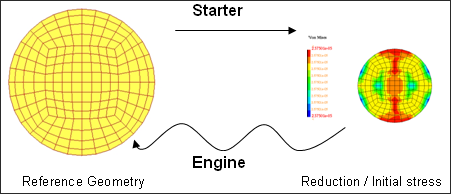More Options
Is it possible to make a static analysis with Radioss Explicit?
It is possible to make static analysis; there is no special limitation in using Radioss options for running a quasi-static analysis.
In order to converge to a non-oscillating solution, one has to use a very progressive and smooth enough loading.
The material density can be artificially increased in order to increase the time step or the option /DT/NODA/CST can be used. In such a case, it is important to check that the kinetic energy remains negligible in the energy balance.
It is also recommended to use QEPH shells instead of Belytschko for this kind of analysis, since they are more accurate.
How to use /DYREL.
This is a low pass filter. For filtering frequencies higher than a certain frequency (which corresponds to the period given in option /DYREL), the computation must be ran during a time greater than .
- Choose to filter the highest frequencies of the system (a short run is sufficient). This allows identifying the following frequencies better (that is to say, the highest frequencies in the remaining signal).
- Then, choose in order to filter these frequencies and so on, until the lowest frequencies of the system can be identified.
What are the recommendations for using /XREF (Reference Metrics)?
Reference Metrics will not work correctly if initial stresses are too high. It is recommended to check the stress level by post-processing the Animation at time t=0.
Radioss Starter generates initial stresses by following the same law; which is used by the fabric (/MAT/LAW19 (FABRI)) from the reference geometry (defined in the reference file) to the initial geometry (defined in Runname_0000.rad).

Figure 1.
If these initial stresses are too high, this process is not smooth enough and the interfaces are too excited.
So the initial size of the elements must be lower than their reference size, and a reduction factor in compression will be used in the corresponding LAW19.
This reduction factor allows representing the low resistance in compression of the fabric, and also allows in case of Reference Metrics to get lower initial stresses and then a smoother deployment.
On the other hand, in case the elements are in tension in some direction with respect to their reference geometry, the initial stress level is generally too high (in this case, a WARNING is written as of Radioss Starter V5.1).

Figure 2. Advise Against folding an Element Along its Diagonal
What is the difference between the condition types in /SPH/INOUT?
- General Inlet (Ityp=1):
The particles are created according to the specified mass flux through the inlet surface (defined by the density and the velocities of the particles), but particles can be created only if there are available ones. Available particles are the remaining particles in the reserve and also the ones deactivated by the outlet. If the inlet runs out of particles the computation stops.
- General Outlet (Ityp=2):
The deactivated particles are the ones that have crossed the outlet surface and that have lost interaction with non-outgoing particles (particles that have not crossed the outlet surface). It means that the particles are deactivated at a certain distance of the outlet surface defined by the position of the particles and by the smoothing length less comprised between h and 2h. This distance has nothing to do with the parameter Dist. Dist is used to define the outgoing particles where the pressure is controlled, but it is recommended to use a value of Dist high enough to be sure that all outgoing particles are controlled.
- Silent boundary (Ityp=3):
Silent boundary is very similar to outlet. The main difference between these two options is the pressure. With Outlet a uniform pressure is imposed on outside particles, it is used to simulate a pressure discontinuity between inside and outside. The silent boundary is used to simulate the presence of a semi-infinite domain with a continuous evolution of the pressure between the outlet surface and the far field. Pressure in the far field is defined by fct_IDp and Fscalep. Silent boundary also prevents wave reflection on the outlet surface.
Why is node deleted when /KEREL is used to smooth the oscillations?
The /KEREL option (Kinetic energy relaxation) sets the nodal velocities to zero each time when the maximum kinetic energy is reached. The kinematic relaxation behavior is like a low-pass filter, it filters initial lower frequencies. When it filters the highest frequency, computation will then diverge. In this case, the model will need to be improved. For example, using a smaller time step may solve this kind of instability issue.
Starter stopped with error "ABNORMAL END", if part is not defined.
“WARNING ID: 1114 ** WARNING WHILE READING DESCRIPTION: THERE IS NO DEFINED PART IN INPUT FILE.”
Or, if elements used in the model, but do not define the part, then Starter will stop with error of “ABNORMAL END”.

Figure 3.